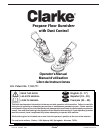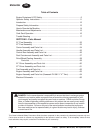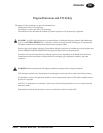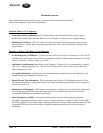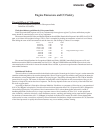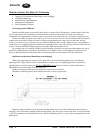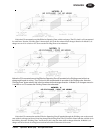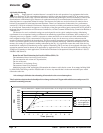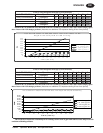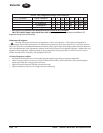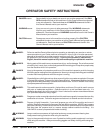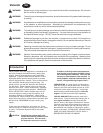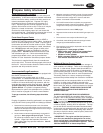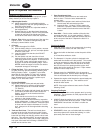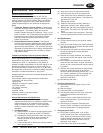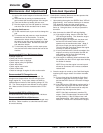
EN
ENGLISH
Page -4-
Clarke
®
Operator's Manual (EN) - DC Propane Burnisher
Document Overview
The information provided in the following overview has been condensed to provide the
reader with a summary of the material presented.
Potential Effects of CO Exposure
• Work place/industry guidelines for CO exposure limits vary substantially from region to region
(OSHA) Permissible Exposure Limit (PEL) for CO is 50 ppm, as an 8-hour time weighted average.
• Definition of CO effects - The toxic effects of carbon monoxide in the blood are the result of tissue
hypoxia (lack of oxygen). The severity depends on the state of activity of the individual and his tissue
oxygen needs.
Methods to Reduce The Risks of CO Poisoning
• Air Exchange and CO Diffusion - CO does not mix with air on its own. Air currents can “stir” the CO
and dilute the concentration values by mixing it with the available air. When using equipment over a large
area in a short time “stirring” occurs as you walk.
• Application Considerations (Burnishing versus Stripping) - When activity is concentrated to a smaller
area as in a stripping application, air “stirring” must be forced by the use of fans to reduce the risk of
high concentrations of CO.
• Air Quality Monitoring – Deployment of a monitor/detector is essential for the safe operation of any
equipment that has the potential to produce CO.
• Room Size and Time Estimations - The concentration and volume of CO production, the size of the
area and the amount of air exchange are factors involved with determining safe time limits for operation
in a specific room size.
• Maintenance of Equipment - LPG engines are dependent on engine tune up, and air filter replacement.
CO concentration (production) skyrockets when the air to fuel ratio becomes fuel rich. Follow the
recommended Maintenance Schedule for the engine.
• Safety Equipment Available. - Envirogard automated fuel to air ratio monitoring and regulation
providing an optimum combustion, three-way type catalytic converter to scrub CO, Hydro Carbons (HC),
and Nitrous Oxide (NOx) from the engine exhaust providing the lowest possible emissions, high cubic feet
per minute (CFM) fans (forced air mixing), and digital combustion analyzers for tail pipe emissions
monitoring.



